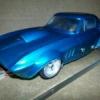I tried to run my recently broken in Hawk 7 and I was upset to say the least. Broken in at 4 volts for 15 mins. and sounded real good. Clean up and installed the gears and tires - tried it out today and it was a dog!
After close examination I noticed that the comm was wrapped with twine like an HO hot stock arm. The spot that was tied was pointed up towards the can hole.
What is the purpose for this? I noticed that the worn motors I had did not have this.
Has anybody had the same problem? Insights?
























